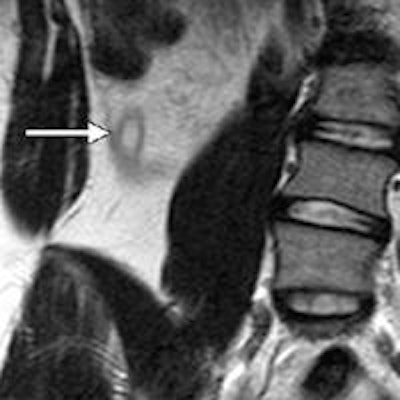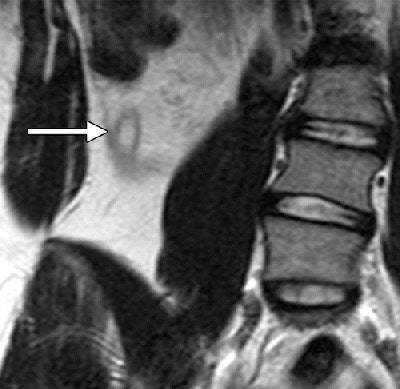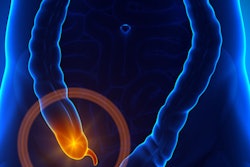
MRI without contrast provides "high diagnostic performance" for suspected pediatric appendicitis and has "substantial" agreement with ultrasound in positive appendicitis cases, indicating that it could be an alternative to both ultrasound and CT for this application, according to a study published online March 17 in Radiology.
Researchers from Texas Children's Hospital in Houston believe the findings are important because ultrasound is not always available at adult healthcare facilities, whereas MRI services are generally maintained around-the-clock. Meanwhile, CT is not an optimal modality for pediatric imaging due to radiation.
More studies are needed to determine the general feasibility and cost-effectiveness of MRI for these pediatric appendicitis cases, though, wrote lead author Dr. Robert Orth, PhD, from the hospital's Edward B. Singleton Department of Pediatric Radiology, and colleagues (Radiology, March 17, 2014).
Disadvantages of ultrasound
Ultrasound traditionally has been the modality of choice when diagnosing a suspected case of appendicitis in a pediatric patient. CT has been used for follow-up when ultrasound is inconclusive or if there is a lingering suspicion of appendicitis despite a normal ultrasound finding.
However, both ultrasound and CT have disadvantages when used in a pediatric population. Regarding CT, recent studies have shown a potential increased risk of radiation-induced malignancy for young patients who undergo as little as one scan.
Meanwhile, ultrasound results are "very operator dependent," and not all adult healthcare facilities have the expertise or ability to perform an ultrasound exam on a pediatric appendicitis patient, according to the authors.
"Facilities at which children are infrequently imaged or where ultrasound availability is limited have until recently faced a choice between CT, an examination that may have long-term health consequences (namely, radiation-induced malignancy), and ultrasound, an examination that is theoretically safer in the long term, but that may provide suboptimal results due to limited experience or resources," Orth and colleagues wrote.
The researchers decided to compare MRI without contrast and ultrasound to see if the former was a viable alternative for pediatric appendicitis. They identified 453 patients between June 2012 and May 2013 who met the study's inclusion criteria. Of those patients, 81 (18%) underwent both ultrasound and MRI scans and were enrolled. The group consisted of 47 girls and 34 boys, with a mean age of 12.4 years (range, 4 to 17 years).
Children younger than 4 years old were excluded because of their inability to remain still or tolerate an MRI exam without sedation. In addition, patients in acute distress, those with contraindications to MRI, or those who had a CT or ultrasound exam performed at a referral facility were excluded.
The mean time between the ultrasound and MRI studies was 2.4 hours (range, 21 minutes to 13 hours). Whether ultrasound or MRI was performed first depended on the availability of the MRI scanner. Ultrasound was performed before MRI in 67 (82%) of the 81 cases.
Ultrasound scans (Logiq E9, GE Healthcare) included grayscale and color Doppler imaging, and both still and cine images were acquired. Abdominopelvic MRI exams were performed without sedation and without contrast on a 1.5-tesla scanner (Achieva or Ingenia, Philips Healthcare), with multichannel cardiac or torso coils based on patient size.
Two pediatric radiologists were blinded to the ultrasound results and independently reviewed the MR images.
Incidence of appendicitis
Thirty patients (37%) had pathologically proven acute appendicitis, the authors wrote. Eight had gross perforation and two had microscopic perforation, for an overall perforation rate of 33%.
A review of the modalities found substantial agreement (κ = 0.77) between MRI and ultrasound when equivocal studies were deemed positive. Agreement between the two modalities was "almost perfect" (κ = 0.92) when equivocal studies were deemed negative.
| MRI and US agreement for pediatric appendicitis | ||
| Measurement | MRI | Ultrasound |
| Equivocal interpretations designated positive | ||
| Sensitivity | 93% | 90% |
| Specificity | 98% | 86% |
| Positive predictive value | 96% | 79% |
| Negative predictive value | 96% | 94% |
| Equivocal interpretations designated negative | ||
| Sensitivity | 93% | 86% |
| Specificity | 98% | 100% |
| Positive predictive value | 96% | 100% |
| Negative predictive value | 96% | 93% |
When equivocal studies were designated positive, there were three false-negative (4%) and seven false-positive (9%) results with ultrasound, compared with one false-negative (1%) and one false-positive (1%) result with MRI.
 MR image of a 13-year-old girl with acute appendicitis and one day of intermittent abdominal pain. Coronal fast spin-echo T2-weighted MRI of the right lower quadrant shows a dilated, fluid-filled appendix (arrow) with decreased signal intensity in the surrounding fat, indicating inflammation and thickening of the lateral conal fascia. Image courtesy of Radiology.
MR image of a 13-year-old girl with acute appendicitis and one day of intermittent abdominal pain. Coronal fast spin-echo T2-weighted MRI of the right lower quadrant shows a dilated, fluid-filled appendix (arrow) with decreased signal intensity in the surrounding fat, indicating inflammation and thickening of the lateral conal fascia. Image courtesy of Radiology.Of the 51 patients who did not undergo an appendectomy, six were lost to follow-up. Clinical follow-up determined that the remaining 45 patients were negative for appendicitis.
There was substantial agreement (κ = 0.76) between the two primary MRI readers when equivocal interpretations were positive, as well as substantial agreement (κ = 0.72) when equivocal interpretations were negative. The two readers disagreed in 16 (20%) of the 81 cases.
"In conclusion, nonenhanced MR imaging demonstrates high diagnostic performance similar to that of ultrasound for suspected pediatric appendicitis," Orth and colleagues wrote. "Future studies are needed to determine general feasibility and cost-effectiveness."
They cited several limitations of the study, including the fact that not all patients were followed up. In addition, four patients went directly to the operating room following ultrasound, which caused a study enrollment bias that could have decreased the positive predictive value of ultrasound. Finally, the study did not evaluate the difference in cost between MRI and ultrasound exams.



.fFmgij6Hin.png?auto=compress%2Cformat&fit=crop&h=100&q=70&w=100)




.fFmgij6Hin.png?auto=compress%2Cformat&fit=crop&h=167&q=70&w=250)











